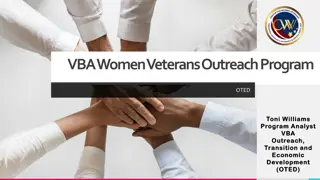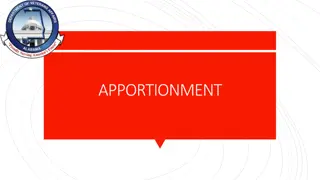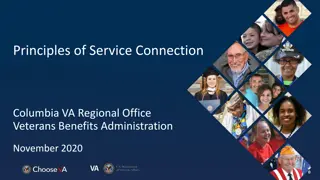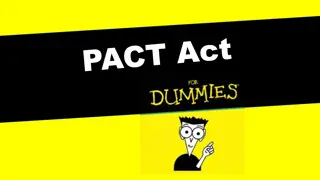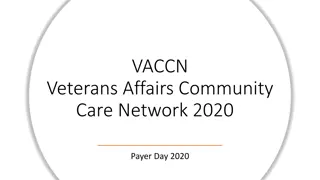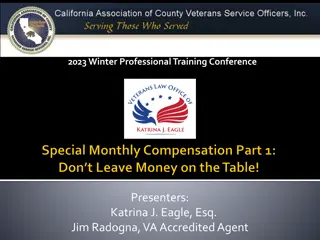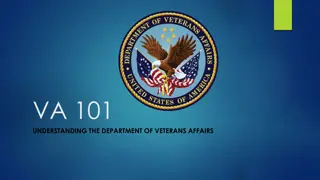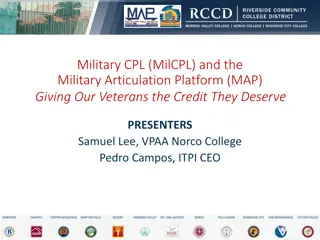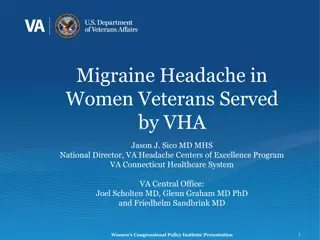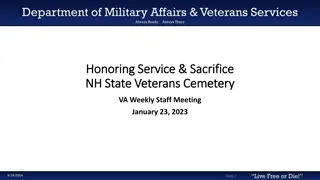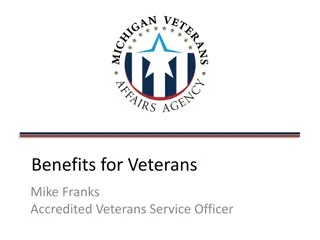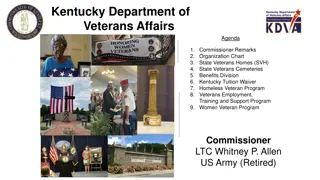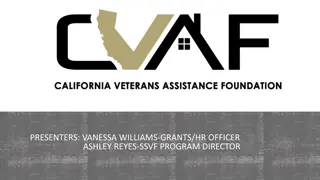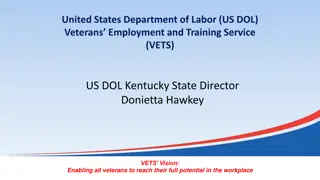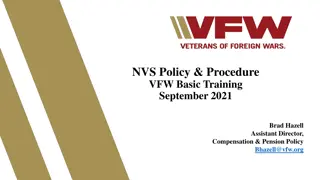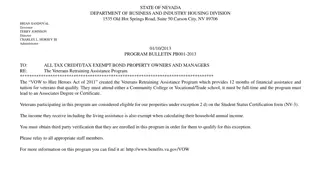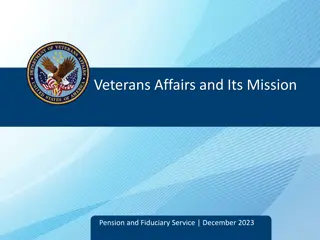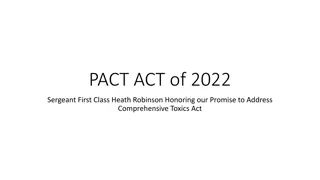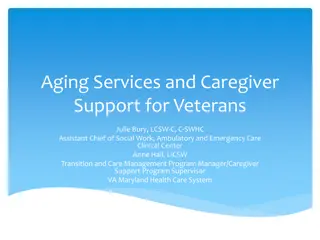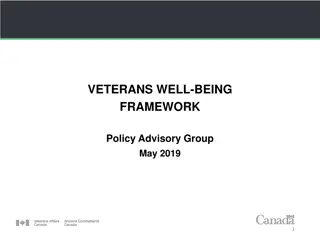Veterans Affairs Compensation and Service Connection Guidelines
The Fall 2020 Professional Training Conference featured presenters discussing important aspects of compensation claims for veterans under U.S.C. 5103A and 38 CFR regulations. The guidelines emphasize the consideration of medical and lay evidence in determining the necessity of medical examinations and assessing service connection for disabilities. Competent lay evidence plays a crucial role in developing claims, while direct service connection, especially in combat-related cases, requires satisfactory evidence consistent with service circumstances. Understanding these principles is essential for assisting claimants effectively.
Download Presentation

Please find below an Image/Link to download the presentation.
The content on the website is provided AS IS for your information and personal use only. It may not be sold, licensed, or shared on other websites without obtaining consent from the author. Download presentation by click this link. If you encounter any issues during the download, it is possible that the publisher has removed the file from their server.
E N D
Presentation Transcript
Fall 2020 Professional Training Conference Presenters: Katrina J. Eagle, Esq. Jim Radogna, VA Accredited Agent
38 U.S.C. 5103A Duty to assist claimants (d)(2): Medical Exams for Compensation Claims: When deciding whether an examination is necessary, the Secretary shall consider the evidence of record, taking into consideration all information and lay or medical evidence (including statements of the claimant).
38 C.F.R. 3.159 VA Assistance in Developing Claims 3.159(a)(2): Competent lay evidence means any evidence not requiring that the proponent have specialized education, training, or experience. Lay evidence is competent if it is provided by a person who has knowledge of facts or circumstances and conveys matters that can be observed and described by a lay person.
38 CFR 3.303 Principles Relating to Service Connection 3.303(a): Service connection connotes many factors but basically it means that the facts, shown by evidence, establish that a particular injury or disease resulting in disability was incurred coincident with service . . . Each disabling condition shown by a Veteran s service records, or for which he seeks a service connection must be considered on the basis of the places, types and circumstances of his service as shown by . . .
38 CFR 3.303 Principles Relating to Service Connection . . . 1. Service records, 2. the official history of each organization in which he served, 3. his medical records 4. and all pertinent medical and lay evidence. Determinations as to service connection will be based on review of the entire evidence of record. . .
38 CFR 3.304 Direct Service Connection 3.304(d) Combat: Satisfactory lay or other evidence that an injury or disease was incurred or aggravated in combat will be accepted as sufficient proof of service connection if the evidence is consistent with the circumstances, conditions, or hardships of such service even though there is no official record of such incurrence or aggravation. See also 38 U.S.C. 1154(b) re Combat Presumption
38 CFR 3.304 Direct Service Connection 3.304(f)(1): if PTSD diagnosis during service: the Veteran s lay testimony alone may establish the occurrence of the claimed in-service stressor. 3.304(f)(2): if Veteran engaged in combat: the Veteran s lay testimony alone may establish the occurrence of the claimed in-service stressor. 3.304(f)(3): if claimed stressor is related to Veteran s fear of hostile military or terrorist activity: the Veteran s lay testimony alone may establish the occurrence of the claimed in-service stressor.
38 CFR 3.307 Presumptive Service Connection 3.307(b) Evidentiary basis: The factual basis may be established by medical evidence, competent lay evidence, or both. Medical evidence should set forth the physical findings and symptomatology elicited by examination within the applicable period. Lay evidence should describe the material and relevant facts as to the Veteran s disability observed within such period, not merely conclusions based upon opinion.
Pursuant to 38 U.S.C. 7104(a), [t]he Board is required to consider all relevant evidence of record and to consider, and discuss in its decision, all potentially applicable provisions of law and regulation. Majeed v. Principi, 16 Vet.App. 421, 431 (2002) The Board s statement of its reasons and bases must provide "a clear analysis of the evidence that it finds persuasive or unpersuasive with respect to the pertinent issue, and to provide the reasons for its rejection of any material evidence favorable to the veteran. Cohen v. Brown, 10 Vet.App. 128, 143 (1997
Whether at a hearing or in a written statement, be sure the testimony is: Competent (i.e., the issue is something they know first- hand) Consistent with evidence and prior statements extant in file Corroborates evidence extant in the file, especially official military records Otherwise, their credibility will be called into question Smith v. Wilkie, 32 Vet. App. 332 (Apr. 27, 2020) (holding that the Board must provide notice or an opportunity for the claimant to respond before changing an earlier favorable credibility determination).
Statement or testimony should describe in as much detail as possible the circumstances of the injury or event during service or describe the symptoms of disease during service, the presumptive period or since service. Look to SMRs, buddy statements, performance reports, newspaper articles, letters from the veteran and others who had reason to know about the incident, and statements of friends and family members to corroborate Vet s statements. Lay evidence should be relevant, e.g. Thailand Vet s statement should put him on or near the base perimeter daily; Korea Vet s should put him on or near the DMZ, etc. ONLY STATE THAT WHICH YOU CAN REASONABLY PROVE!
Section 1154(b): In the case of any veteran who engaged in combat with the enemy the Secretary shall accept as sufficient proof of service-connection satisfactory lay or other evidence if consistent with the circumstances, conditions, or hardships of such service, notwithstanding the fact that there is no official record of such incurrence or aggravation and, to that end, shall resolve every reasonable doubt in favor of the veteran. Service-connection of such injury or disease may be rebutted by clear and convincing evidence to the contrary. The reasons for granting or denying service-connection in each case shall be recorded in full.
Ways to corroborate combat service: Service Records Military Decorations* Hazardous Duty Pay Buddy Statements Evidence that base was attacked by enemy VA cannot conclude the veteran did not engage in combat simply because a veteran did not have a MOS, award, or decoration indicating combat. It must consider all evidence. *Purple Heart, Combat Medical Badge, Air Medal with "V" Device, Distinguished Flying Cross, Army Commendation Medal with "V" Device, Distinguished Service Cross, Bronze Star Medal with "V" Device, Combat Aircrew Insignia, Combat Action Ribbon, Air Force Cross, Combat Infantry Badge, Medal of Honor, Navy Commendation Medal with "V Device, and the Silver Star.
CAVC held that a non-combat veterans lay statements must be weighed against other evidence, including the absence of military records supporting the lay assertions. Bardwell v. Shinseki, 24 Vet. App. 30, 40 (2010).
When the stressor is not related to combat, a veteran's testimony alone does not qualify as "credible supporting evidence" of the occurrence of an in-service stressor. After-the-fact psychiatric analyses which infer a traumatic event are likewise insufficient in this regard. Exceptions are fear of hostile military or terrorist activity diagnosed by VA psych or MST cases.
While the lack of contemporaneous medical records may be a fact that the Board can consider and weigh against a veteran s lay evidence, the lack of such records does not, in and of itself, render lay evidence not credible. Buchanan v. Nicholson, 451 F. 3d. 1331, 1336 (2006). CAVC found that there must be some valid basis to support an inference that a veteran s testimony concerning an alleged injury or event would have been recorded in a medical record for the lack of any such recording to serve as the basis for finding the veteran s testimony incredible. Kahana v. Shinseki, 24 Vet. App. 428, 433 34 (2011). Example: Unreported personal assault
Where the determinative issue involves either medical etiology or a medical diagnosis, competent medical evidence is required where the determinative issue does not require medical expertise, lay testimony may suffice by itself. Caluza v. Brown, 7 Vet. App. at 504 (1995). The Federal Circuit suggested a broken leg as an example of when a lay person may be competent to make a diagnosis and cancer as an example of when a lay person is not. Jandreau v. Nicholson, 492 F. 3d 1372, 1376 77 (2007).
Lay evidence can be competent and sufficient to establish a diagnosis of a condition when: 1. A layperson is competent to identify the medical condition 2. The layperson is reporting a contemporaneous medical diagnosis (i.e., where the veteran states that a doctor told the veteran that the veteran suffered from a particular diagnosed condition) 3. Lay testimony describing symptoms at the time supports a later diagnosis by a medical professional
As a general matter, in order for any testimony to be probative of any fact, the witness must be competent to testify as to the facts under consideration. Layno v. Brown, 6 Vet. App. 465, 469 (1994). Alay witness is competent to attest to factual matters of which he or she has first-hand knowledge Washington v. Nicholson, 19 Vet.App. 362, 368 (2005). Example: A Veteran s testimony or buddy statements as to where he performed his military duties is competent even in absence of corroborating records (e.g. JSRRC)
A witness is competent to provide such testimony or sworn statements if, among other things, he or she possesses personal knowledge of the disputed fact and the expertise necessary to testify as to that fact. Wise v. Shinseki, 26 Vet. App. 517, 528 (2014). Example: Although a Veteran witnessed foliage being sprayed, he doesn t necessarily have the expertise to determine the type of herbicide used
VA cannot reject a veterans competent lay statements regarding in-service events simply because the service records do not corroborate the events. See Jandreau v. Nicholson, 492 F. 3d 1372 (2007). VA must point to something in the claims file that supports a conclusion that the event would have been documented in the service records had it actually occurred. Buczynski v. Shinseki, 24 Vet. App. 221, 224 (2011).
CAVC held that the Board may not disregard a medical opinion solely on the rationale that the medical opinion was based on a history given by the veteran. Kowalski v. Nicholson,19 Vet.App. 171, 179-80 (2005). Fountain v. McDonald, 27 Vet.App. 258, 274(2015) (finding error in the Board s failure to adequately explain its determination that a lay person is not competent to provide etiology evidence for a condition like tinnitus).
Lack of evidence cannot be substantive negative evidence. Horn v. Shinseki, 25 Vet. App. 231, 239 (2012). The Federal Circuit held that it would be "legally untenable" for VA to conclude "that absent confirmatory [record] evidence, lay evidence lacks credibility," and explained that "the lack of such records does not, in and of itself, render lay evidence not credible. Buchanan v. Nicholson, 451 F. 3d. 1331, 1336 (2006)
However, VA may validly reject a veterans statement that if the veteran s statement were really true, there should be some federal agency records that corroborate the statement and the available records do not corroborate the statement.
CAVC has held that the reasons or bases requirement of 38 U.S.C. 7104(d)(1) . . . requires the BVA to explicitly determine the credibility of a veteran s sworn testimony when that testimony can be the basis for the benefits the veteran seeks and that the Board s failure to do so renders its reasons or bases for its decision not to increase the veteran s disability rating inadequate for review. Ashmore v. Derwinski, 1 Vet.App. 580, 583-84 (1991).
Lay evidence can be extremely useful in proving service connection claims as long as it meets the definition of competent evidence. The problems with lay evidence arise when claimants try to use lay evidence to prove something beyond their own experience or expertise, such as the medical connection between an in-service injury and a current disability. Competent lay evidence submitted by a claimant must be considered by the VA and the Board of Veterans Appeals when deciding a claim for benefits.
Feel free to contact us about questions from this training or ANYTIME you have a question about a claim: CACVSO@eagleveteranslaw.com

 undefined
undefined









